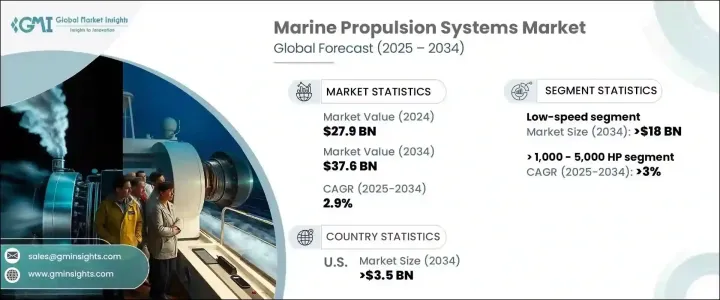
세계의 선박용 추진 시스템 시장은 2024년에 279억 달러로 평가되었으며 2025년부터 2034년에 걸쳐 CAGR 2.9%를 나타낼 것으로 예측됩니다.
이 시장의 주요 원동력은 세계 해상 무역의 확대와 선대 규모의 지속적인 확대이며, 첨단 추진 기술에 대한 안정적인 수요에 박차를 가하고 있습니다. 국제무역이 계속 활발해짐에 따라 대형 선박과 무거운 화물 적재량을 관리할 수 있는 효율적이고 고성능의 추진 시스템에 대한 요구가 급증하고 있습니다.

경제의 세계화는 상품 무역을 뒷받침할 뿐만 아니라 연료 효율을 극대화하고, 운항 비용을 줄이고, 환경에 미치는 영향을 최소화하도록 설계된 최첨단 추진 시스템의 개발을 가속화하고 있습니다. 각 제조업체는 원하는 운영 효율성을 유지하면서 진화하는 규제 요구 사항과 지속가능성 기준을 충족하는 솔루션을 만드는 데 중점을 둡니다. 그린테크놀로지에 대한 주목 증가와 업계 내 탈탄소화의 추진이 이 역동적인 시장 상황을 형성하는 주요 촉진요인이 되고 있습니다.
| 시장 범위 | |
|---|---|
| 시작 연도 | 2024년 |
| 예측 연도 | 2025-2034년 |
| 시작 금액 | 279억 달러 |
| 예측 금액 | 376억 달러 |
| CAGR | 2.9% |
저속 추진 기술의 채용은 시장의 미래를 형성하는 데 중요한 역할을 할 것으로 예상되며, 2034년까지 180억 달러의 가치가 예상됩니다. 이 성장의 원동력이 되는 것은 비용 효율적인 연료에 대한 수요 증가이며, 이는 장거리 무역 항로와 연료 효율이 높은 선박 옵션에 대한 세계의 의존도 증가에 직결하고 있습니다. 국제 해양 규제도 이러한 변화에 중요한 역할을 하고 있으며, 선주와 운영자는 보다 엄격한 배출 기준을 충족하는 솔루션을 찾고 있습니다. 배출규제지역(ECA)이 확대됨에 따라 보다 깨끗하고 효율적인 추진기술에 대한 투자는 증가의 길을 따라가고 있습니다. 또한 조선 부문은 현저한 진보를 이루고 있으며, 설계 혁신과 지속가능성을 모두 제공하는 선박용 추진 시스템에 대한 요구가 더욱 커지고 있습니다.
1,000-5,000마력(HP) 이상의 선박용 추진 시스템은 2034년까지 연평균 복합 성장률(CAGR) 3%를 나타낼 것으로 예측됩니다. 이러한 시스템은 입증된 효율성, 내구성, 엄격한 조건을 견딜 수 있는 능력으로 해사 산업, 특히 화물선, 유조선, 장미화물 화물선 및 컨테이너선에서 높은 지지를 받고 있습니다. 환경의 지속가능성에 대한 관심 증가와 해상무역에 대한 의존도 증가는 이 범주 성장에 기여하는 중요한 요인입니다. 기술의 진보로 성능이 지속적으로 향상되고 유지보수 비용이 절감되고 에너지 효율이 향상됨에 따라 이러한 추진 시스템은 현재 환경 실적를 최소화하면서 운항 출력을 극대화하는 데 필수적인 것으로 간주되고 있습니다.
미국의 선박용 추진 시스템 시장은 2034년까지 35억 달러에 이를 것으로 예측됩니다. 고출력 선박용 엔진에 대한 투자 증가는 이 나라의 까다로운 환경 기준을 충족하도록 설계된 효율적이고 신뢰할 수 있는 추진 솔루션에 대한 수요를 촉진하고 있습니다. 배기 가스 규제 기술의 지속적인 채용은 이러한 솔루션을 지원하는 중요한 요소이며 제조업체는 강력한 엔진 출력을 제공하면서 규제를 충족시킬 수 있습니다. 이러한 시스템은 중유를 이용하면서 회전 속도를 낮추고 큰 출력을 제공할 수 있기 때문에 매력이 증가하고 있습니다. 열효율이 향상됨에 따라 이러한 고성능 추진 시스템은 시장을 계속 견인하고 업계의 지속적인 성장을 위한 강력한 기반을 구축할 것입니다.
The Global Marine Propulsion Systems Market was valued at USD 27.9 billion in 2024 and is set to grow at a CAGR of 2.9% from 2025 to 2034. The market is primarily driven by the expansion of global maritime trade and the continuous increase in fleet sizes, fueling a steady demand for advanced propulsion technologies. As international trade continues to flourish, the need for efficient, high-performance propulsion systems capable of managing larger vessels and heavier cargo loads has surged.

Economic globalization is not only boosting merchandise trade but also accelerating the development of cutting-edge propulsion systems designed to maximize fuel efficiency, reduce operational costs, and minimize environmental impact. Manufacturers are placing a strong focus on creating solutions that align with evolving regulatory requirements and sustainability standards while maintaining the desired operational efficiency. The growing focus on green technology and the push for decarbonization within the industry are key drivers shaping this dynamic market landscape.
| Market Scope | |
|---|---|
| Start Year | 2024 |
| Forecast Year | 2025-2034 |
| Start Value | $27.9 Billion |
| Forecast Value | $37.6 Billion |
| CAGR | 2.9% |
The adoption of low-speed propulsion technology is expected to play a significant role in shaping the future of the market, with an estimated value of USD 18 billion by 2034. This growth is fueled by the rising demand for cost-effective fuels, which is directly linked to long-distance trade routes and the increasing global reliance on fuel-efficient shipping options. International maritime regulations also play a critical role in this shift, as shipowners and operators seek solutions that comply with stricter emissions standards. As Emission Control Areas (ECAs) expand, investments in cleaner and more efficient propulsion technologies continue to rise. In addition, the shipbuilding sector is seeing significant advancements, further solidifying the growing need for marine propulsion systems that offer both innovation and sustainability in their design.
Marine propulsion systems in the >1,000 to 5,000 horsepower (HP) power range are projected to grow at a CAGR of 3% through 2034. These systems are highly favored in the maritime industry, particularly in cargo vessels, tankers, bulk carriers, and container ships, due to their proven efficiency, durability, and ability to withstand demanding conditions. The increased focus on environmental sustainability and the growing reliance on seaborne trade are significant factors contributing to the growth in this category. With technological advancements continuously improving performance, reducing maintenance costs, and enhancing energy efficiency, these propulsion systems are now seen as essential for maximizing operational output while minimizing the environmental footprint.
In the U.S. marine propulsion systems market, projections indicate a value of USD 3.5 billion by 2034. Rising investments in high-powered marine engines are driving the demand for efficient and reliable propulsion solutions designed to meet the country's stringent environmental standards. The continued adoption of emission control technologies is a key factor in supporting these solutions, allowing manufacturers to meet regulations while still providing powerful engine output. The ability of these systems to deliver substantial power at reduced rotational speeds while utilizing heavy fuel oil is increasing their appeal. As thermal efficiency improves, these high-performance propulsion systems continue to gain market traction, laying a strong foundation for sustained industry growth.